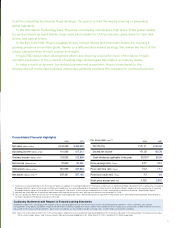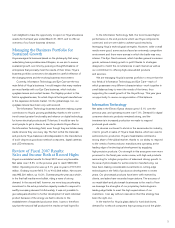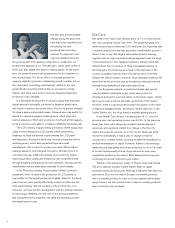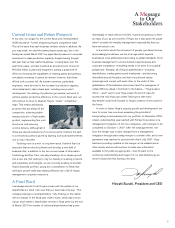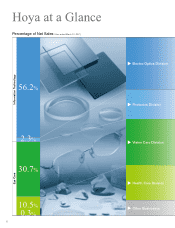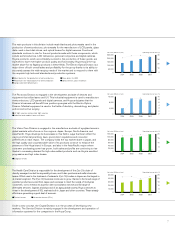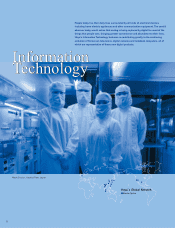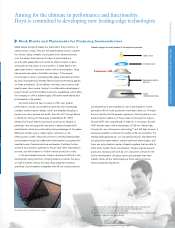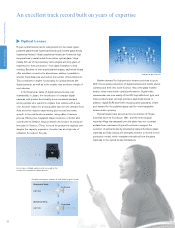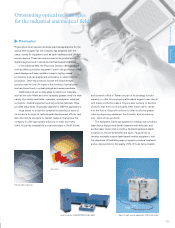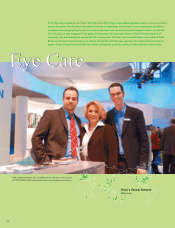Pentax 2007 Annual Report Download - page 6
Download and view the complete annual report
Please find page 6 of the 2007 Pentax annual report below. You can navigate through the pages in the report by either clicking on the pages listed below, or by using the keyword search tool below to find specific information within the annual report.
4
We also saw a technological
change during the year, with
hard disk drive manufacturers
introducing the new
perpendicular recording
method. To respond to the
vigorous demand driven by
the growing shift from desktop computers to notebooks, we
boosted the capacity of our Vietnam plant, which came online in
2005, and also added new lines to existing plants. At the same
time, we pushed forward with preparations for the transition to
new technologies. Our all-out effort to increase production
capacity helped to generate outstanding growth in sales, but on
the other hand, technology development related to the new
perpendicular recording method did not proceed in a timely
manner, and there were some temporary shipping delays and
production cost overages.
In a favorable development for Hoya’s optical lens business,
digital camera functionality continued to heighten added value,
with higher resolution and zoom ratios. This led to greater demand
for Hoya’s aspherical molded lenses. Demand also rose swiftly for
lenses for camera-equipped mobile phones, which Hoya first
started shipping in 2004, and production continued at full capacity,
so as a result we were able to increase profitability this fiscal year.
The LCD industry is approaching a situation where supply may
vastly exceed demand for LCD panels, which presented a
challenge to Hoya’s business in photomasks for LCD panel
manufacturers. During the fiscal year, intense competition led to
declining prices, which also impacted Hoya as a mask
manufacturer. We continue to pursue a product differentiation
strategy based on technological innovation. We also strove to
overcome the year’s difficult business environment by further
improving product quality and enhancing cost competitiveness
through adopting integrated production systems, starting with the
mask blanks that are base plate materials for photomasks.
In the Photonics division, Hoya’s pattern defect correction
equipment, which is used in the production of LCD panels, is
responsible for the largest proportion of sales. Sales for the fiscal
year, however, were greatly affected by market conditions in the
LCD panel industry. We are working on the product mix, cost
reduction, and new product development with the primary objective
of improving profitability, but still, due to the strong competition
that characterizes this segment, net sales and operating income
decreased year-on-year.
Eye Care
Net sales in the Vision Care division grew 14.7% on the previous
year, and operating income rose 3.9%. The global eyeglass lens
market is growing at a leisurely 2-3% each year, but Hoya was able
to achieve growth at a rate that exceeded overall market growth. I
think it is fair to say that Hoya’s value-added product strategy
together with its region-specific business approach were the keys
to this achievement. The Japanese domestic market, which has
hitherto been the cornerstone of Hoya’s eyeglass business, is
showing signs of contracting as a result of the decrease in the
country’s population and an influx of budget product from Asia.
Despite the difficult market, however, Hoya maintained sales at the
same level as the previous year by introducing new products and
strengthening marketing of high-value-added lines.
In our European markets, we achieved double-digit growth
using localization strategies, under which each product is
developed and sold to suit local tastes. In the Asian region, clients
favoring low-cost products still make up the bulk of the market.
However, there is a growing trend toward recognition of the value
of high-end eyeglass lenses, and Hoya’s results improved. In the
United States, too, the Hoya brand is steadily gaining ground.
In the Health Care division, net sales grew 15.1% over the
previous year, and operating income rose 34.3%. In the previous
fiscal year, there were temporary research and development
expenses, and expenses related to a change in the Eye City
chain’s bonus points scheme, so in the current fiscal year profit
recovered dramatically. It was a year of change in market
conditions for contact lenses, including modified fee standards for
medical examinations in Japan. However, thanks to the strategic
marketing and high-quality services provided by our Eye City chain
of contact lens specialty stores, Hoya secured an even more
competitive position in the market. Both sales and income grew,
continuing the growth reported a year earlier.
Thanks to the well-known quality of Hoya’s intraocular lenses
(IOLs) for cataract surgery, Hoya’s market share in Japan
increased during the fiscal year. Although it has been less than two
years since IOLs went on sale in Europe, our market presence
there is steadily growing. In order to further expand market share
going forward, we will continue both to improve existing products
and to introduce new products.



